Going into this game I was completely unfamiliar with the world of Utawarerumono: Mask of Deception. As someone who’s only dabbled in visual novels, I was a little nervous to dive into the deep end, but considering how many fans this series has, I had to see what the fuss was all about; with the benefit of loving tactical games like Fire Emblem, I knew I was in for a good time. Utawarerumono: Mask of Deception surprised me in a lot of ways, but does the visual novel turned strategy game stand up to the competition? It isn’t what I expected, but let me show you what I found.
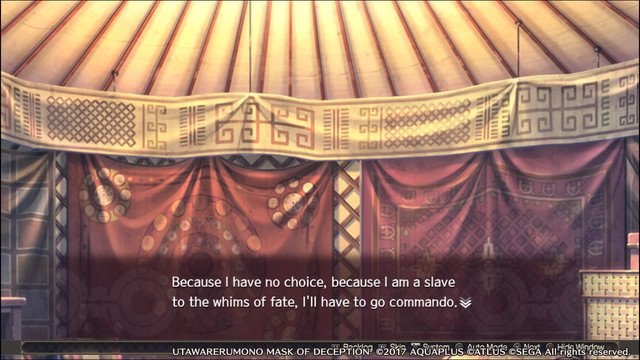
Utawarerumono: Mask of Deception is a light novel strategy RPG originally released in Japan in 2015. Fans of the 2015 anime, Utawarerumono: The False Faces,will be familiar with the story: a man with no memory wakes on a frosty mountain he does not recognize. His amnesia quickly becomes the least of his concerns when he is pursued by a ferocious Boro-Gigiri (read: giant centipede), and just as it looks like our game is over before it even begins, he’s saved by a girl with a cat ears and a tail named Kuon, who takes him under her wing and gives him the name “Haku”. From there, Kuon and Haku embark on a wanderlust adventure together, meeting a cavalcade of animal-girls along the way.
It’s hard to go any further without dipping into spoiler territory because, at it’s core, Utawarerumono: Mask of Deception is a visual novel; story is the main event here. Through most of the game, you’ll be experiencing a linear narrative filled with character moments that are sometimes comical, sometimes sexual, sometimes violent, and sometimes all three combined as Haku and Kuon travel across the eclectic land of Yamato.
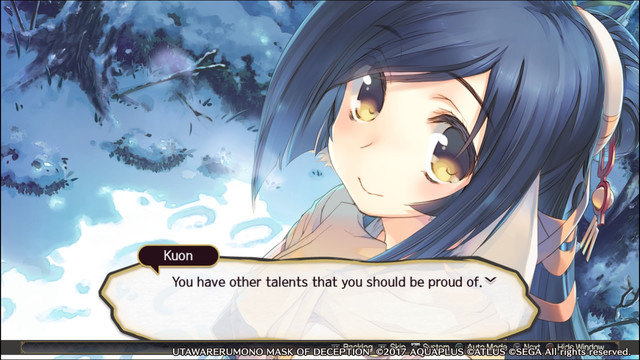
Scenes play out with fully voice acted Japanese dialogue and detailed character portraits, set over warm and evocative artwork. Occasionally the game presents new artwork for certain scenes, which can be revisited later in the gallery, and while some of the more titillating scenes may be uncomfortable for some players, considering the series is based on an adult game, Mask of Deception keeps things relatively tame.
Haku is our main protagonist for this adventure, and like most average people thrown into a fantasy setting, he’s a bit of a wimp. A lot of humor comes from Haku’s complaining and physical weakness in his new harsher environment. Although he has no memory of his past, it’s quickly revealed that while Haku flounders at manual labor and combat, he excels at math and more thoughtful endeavors. Though he belly-aches through most of the first act, Haku genuinely cares about the people around him, and quickly became one of my favorite characters.
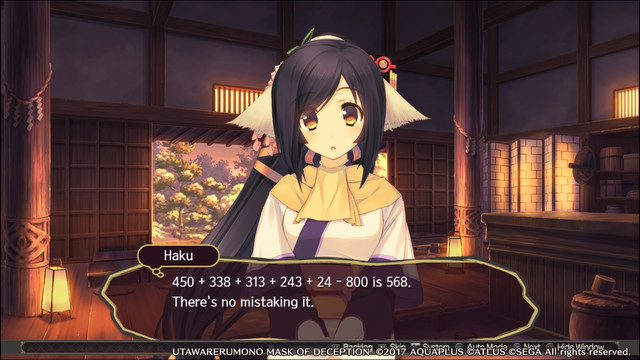
Where Haku is weak and booksmart, Kuon is strong and compassionate. While her true reason for traveling will undoubtedly be revealed by the end of our story, she claims to be on a journey to find herself, and explore the world. Kuon also seems to have a soft spot for baths (which the game takes full advantage of), and is innocently curious about her new male companion and all of his unique features like... not having animal ears! (*cough cough*)
While the rest of the cast shifts relatively rapidly, the plot moves at a comfortable clip that allows the various characters like Ukon, the general of a friendly band of samurai, and Maroro, his magician friend, have some fun on screen before they’re politely asked to exit the stage. Even though some characters feel cliche (Rurutie the soft spoken princess who rides a bird, and Nekone the brilliant little sister character), after spending some time with them, I found they all felt like they had dimension, and left a strong impression on me.
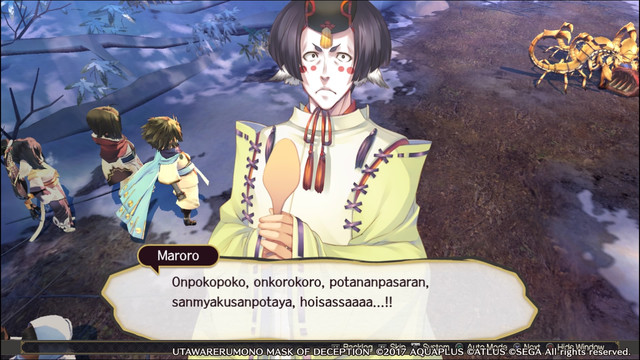
[the story of Utawarerumono would be almost indecipherable without the glossary.]
In addition to a huge cast of characters, there are countless locations, creatures, and cultures you’ll need to learn about to understand everything happening in Utawarerumono’s story. In fact, Yamato is a world so rich with lore and proper nouns that the game provides players with a glossary that fills up as the game progresses, and trust me, you’ll need it. A very handy feature, the glossary provides spoiler-free descriptions of people, places and things, and in a story this dense, it’s very helpful to be able to pull up at any time. In addition to story entries, the glossary is also loaded with tutorials for the combat sections of the game.
That’s right, visual novel segments are broken up by combat, which is where the strategy RPG part of the game comes into play! Players familiar with Final Fantasy Tactics will be right at home in the familiar turn-based battle system where you issue commands to a team of up to six characters. Characters have a variety of moves they can use on enemies, adding to the complexity of fights, particularly when elemental weaknesses come into play. Attacks are made more engaging with the inclusion of “chain attacks”, timed button presses during the attack animations that reward bonus damage. Admittedly, these sections are somewhat few and far between; in some cases returning to the visual novel for almost an hour before the next conflict arises.
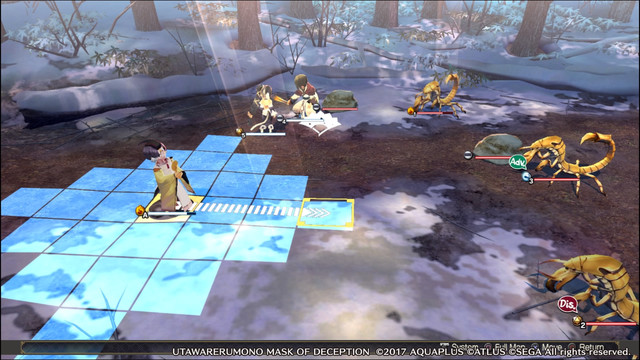
Utawarerumono can be as difficult as you want it to be. In addition to the standard difficulty settings, players can elect to have chain attacks succeed automatically, meaning you’ll always hit for maximum damage. Moreover, the game has a rewind function, which allows players to revert back to any previous turn and make different decisions. While these optional features do make the game significantly easier, every encounter requires at least some strategy, and many offer alternate win conditions to keep things interesting. While I didn’t find combat to be particularly deep, the encounters are memorable, and are a fun way to let some of the characters shine outside of the visual novel.
Occasionally, after a healthy chunk of story, players will be presented with a break where they can choose where they’d like to go next. These screens may appear open ended, but really only offer the illusion of choice; to progress the story you must go through every scene, the only real decision is in which order you’d like to view them.
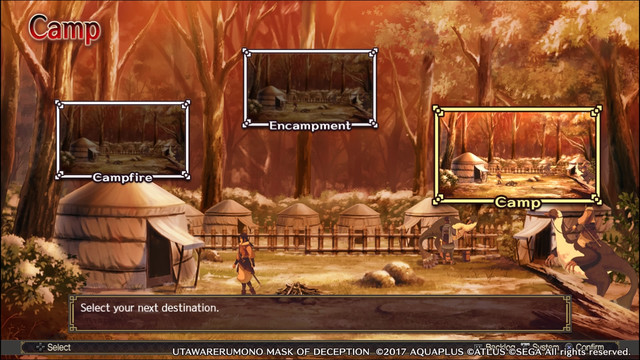
[How many different ways can you say “camp”?]
These moments of respite do offer another convenient feature, however: free battle mode. Free battle allows players to return to any previous fight and replay them to take a break from the visual novel and earn experience points and bonus points. This was a great decision, as it allows players to engage in the combat as they like without the need to shoehorn in more battles into the story. While I personally didn’t take advantage of it much, the inclusion allows players to enjoy the game however they like.
The strength of Utawarerumono is in it’s characters. Even during combat, party members will chirp in with humorous, interesting perspectives, and help to create a world that you want to explore. Kuon in particular walks a line between being caring, funny, and, when she needs to be, serious. Everything about the game feels like an extended stay in an anime series. It’s packed with as many raunchy, silly moments as it has thoughtful, moving scenes. Through their interactions, the characters depict a compelling world that is worth spending time in.
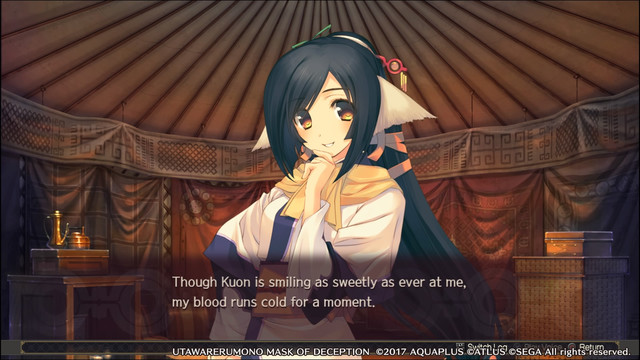
I feel it’s important to take a moment in this review to mention that there are countless Japanese games that never see an international release. Localization is a daunting process, even for a simple game, so it’s impressive that Utawarerumono: Mask of Deception is available in English at all. Visual novels in particular, being so text heavy by design, are a rare breed outside of Japan, so it’s worth appreciating how much effort went into this title, especially in reference to the quality of the localization.
Utawarerumono: Mask of Deception at its core is a fantasy visual novel. While the combat is engaging, it takes the back seat to a well crafted world filled with enjoyable characters. To say that visual novels aren’t mainstream would be an understatement, and although I’ve only played a few visual novels, I really enjoyed my time with the game. Visual novel veterans will enjoy a romp with delightful characters with unique designs, while newcomers will be whisked away to beautiful locales broken up by bite-sized sections of strategic action. Utawarerumono: Mask of Deception provides avenues for players to play how they want to, and while it may not make a huge splash in the world of gaming, I look forward to many more hours spent with these characters.
REVIEW ROUNDUP
+ A vast and colorful world filled with bubbly, interesting characters.
+ Well written localization that feels fitting, even in the more silly scenarios.
+ A compelling story that makes you look forward to spending time with the game.
+/- An adaptable system that allows the game to be as easy or difficult as the player wants.
+/- More than a few “I hope no one walks into my room right now” scenes.
- Very long visual novel segments that could benefit from more combat intermixed.
- A combat system that, while fun, doesn’t ever feel terribly deep.
No comments:
Post a Comment